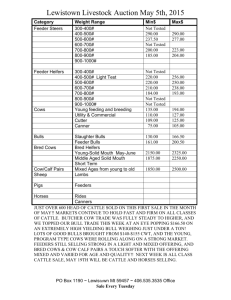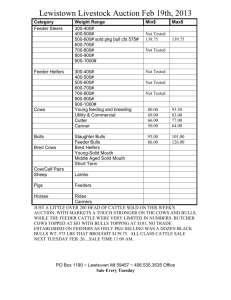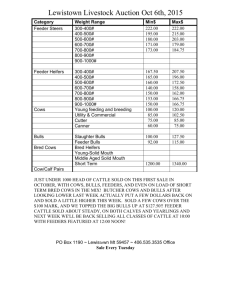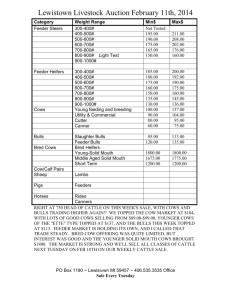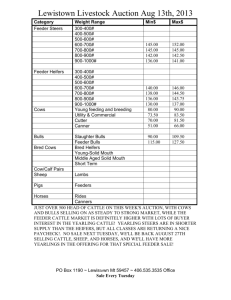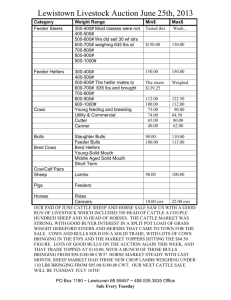Newsletter - UC Cooperative Extension
advertisement
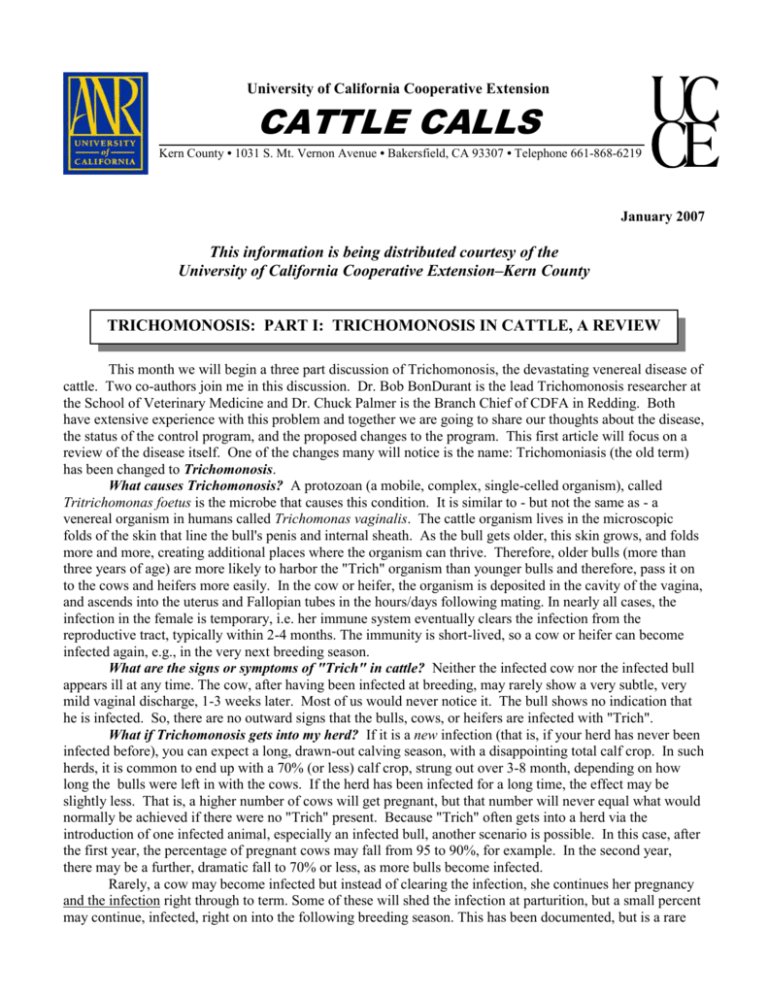
University of California Cooperative Extension CATTLE CALLS Kern County • 1031 S. Mt. Vernon Avenue • Bakersfield, CA 93307 • Telephone 661-868-6219 January 2007 This information is being distributed courtesy of the University of California Cooperative Extension–Kern County TRICHOMONOSIS: PART I: TRICHOMONOSIS IN CATTLE, A REVIEW This month we will begin a three part discussion of Trichomonosis, the devastating venereal disease of cattle. Two co-authors join me in this discussion. Dr. Bob BonDurant is the lead Trichomonosis researcher at the School of Veterinary Medicine and Dr. Chuck Palmer is the Branch Chief of CDFA in Redding. Both have extensive experience with this problem and together we are going to share our thoughts about the disease, the status of the control program, and the proposed changes to the program. This first article will focus on a review of the disease itself. One of the changes many will notice is the name: Trichomoniasis (the old term) has been changed to Trichomonosis. What causes Trichomonosis? A protozoan (a mobile, complex, single-celled organism), called Tritrichomonas foetus is the microbe that causes this condition. It is similar to - but not the same as - a venereal organism in humans called Trichomonas vaginalis. The cattle organism lives in the microscopic folds of the skin that line the bull's penis and internal sheath. As the bull gets older, this skin grows, and folds more and more, creating additional places where the organism can thrive. Therefore, older bulls (more than three years of age) are more likely to harbor the "Trich" organism than younger bulls and therefore, pass it on to the cows and heifers more easily. In the cow or heifer, the organism is deposited in the cavity of the vagina, and ascends into the uterus and Fallopian tubes in the hours/days following mating. In nearly all cases, the infection in the female is temporary, i.e. her immune system eventually clears the infection from the reproductive tract, typically within 2-4 months. The immunity is short-lived, so a cow or heifer can become infected again, e.g., in the very next breeding season. What are the signs or symptoms of "Trich" in cattle? Neither the infected cow nor the infected bull appears ill at any time. The cow, after having been infected at breeding, may rarely show a very subtle, very mild vaginal discharge, 1-3 weeks later. Most of us would never notice it. The bull shows no indication that he is infected. So, there are no outward signs that the bulls, cows, or heifers are infected with "Trich". What if Trichomonosis gets into my herd? If it is a new infection (that is, if your herd has never been infected before), you can expect a long, drawn-out calving season, with a disappointing total calf crop. In such herds, it is common to end up with a 70% (or less) calf crop, strung out over 3-8 month, depending on how long the bulls were left in with the cows. If the herd has been infected for a long time, the effect may be slightly less. That is, a higher number of cows will get pregnant, but that number will never equal what would normally be achieved if there were no "Trich" present. Because "Trich" often gets into a herd via the introduction of one infected animal, especially an infected bull, another scenario is possible. In this case, after the first year, the percentage of pregnant cows may fall from 95 to 90%, for example. In the second year, there may be a further, dramatic fall to 70% or less, as more bulls become infected. Rarely, a cow may become infected but instead of clearing the infection, she continues her pregnancy and the infection right through to term. Some of these will shed the infection at parturition, but a small percent may continue, infected, right on into the following breeding season. This has been documented, but is a rare event. Our best guess as to the frequency of such “carrier cows” is a range, from 0.05% to about 0.1% of all cows in the herd (1 or 2 per 2,000 cows). Does the disease cause abortions? It can, but most cows do not abort a fetus big enough to find. The crows, buzzards or coyotes probably find them before we do. Instead, these cows come back into heat at some extended interval (more than 21 days) after breeding. At pregnancy check time, these cows are diagnosed open; or if they have conceived to a second breeding after losing the first pregnancy, they may be diagnosed as pregnant, but with a short-gestation calf that will be born late. The reason for the open or late cows is that the Tritrichomonas organism causes the loss of the early fetal calf, beginning about 2 months into the pregnancy. A few "Trich"-infected cows in the herd may actually abort a fetus big enough to be found, nearly always before six months' gestation. (Note: At six months’ gestation, a typical bovine fetus is about the size of a beagle.) However, there are many causes of such “frank abortion”, and Trichomoniasis is just one, and a less common one at that. Trich does most of its damage earlier in gestation. So don't assume that every abortion is a sign of "Trich". A few cows (perhaps another 1-2%) may develop pyometra, i.e., a heavy, pus-filled uterus, after being infected. A qualified veterinarian can detect this pyometra at pregnancy check time. Cows or heifers with pyometra at the time of pregnancy check (as opposed to after calving) should make you very suspicious about Trichomoniasis. How is Trichomonosis transmitted? Trichomonosis is a venereal disease of cattle (all breeds). It is transmitted from cow to cow by a bull, so it is nearly always a disease of cattle that are naturally bred, as opposed to artificially inseminated (AI’ed) cattle. Very rarely, it can be transmitted by contaminated semen or AI equipment, but this is highly unlikely if semen is purchased from reputable bull studs. If you use AI, look for semen carrying the “CSS” logo on the straw. This label certifies that the hygienic procedures for ensuring that AI bulls are negative for Trichomonosis before their semen in collected have been followed. Reputable AI studs take great pains to assure that their product (bovine semen) is free of Tritrichomonas foetus. This is part of the reason that AI is commonly recommended for a herd that is experiencing Trich. How common is Trichomonosis in cattle? Bovine Trichomonosis has been--and continues to be an important cause of economic loss in cattle operations that use natural service. In the Western U. S., where extensive grazing (vs. intensive grazing on permanent pasture) management practices are employed, the disease is prevalent at surprisingly high rates. In 1990, a random survey of California beef cattle operations revealed that nearly 16% of herds were infected (i.e., they had at least one infected bull). Several factors such as shared grazing, renting or borrowing bulls, large areas of common fence lines, etc. favor transmission of "Trich" from one herd to another. How can I tell if my herd has it? In spite of the fact that bulls don't show any signs, the organism is easier to find in bulls than in cows, because bulls become “carriers” while cows eventually shed the infection. Special culture media have been developed that can support growth of the organism in an incubator. Scrapings of preputial (internal sheath) fluids are taken, and placed in this medium, which is then cultured for up to a week. If even one bull is positive, you have to assume that the herd is infected. Is the diagnosis a sure thing? No, but the technique used is quite good, as diagnostic tests go. Studies of known "positive" bulls have shown that the culture method may miss about 10-19% of infected bulls if we only test them once. But testing the herd (all the bulls in the herd) once gives us a 90% chance of finding the disease if it's there. If no infected bulls are found on the basis of a single culture of all bulls, then we can be about 90% sure that the bull herd is "clean". Repeat testing (up to three times, at weekly intervals) is necessary if we want to be 99% sure that the entire bull herd is negative. It's important to give the bulls 1-2 weeks' of sexual rest before beginning to test them for Trich. This allows time for the numbers of organisms to build up to a level that can be detected. Are there false positives as well as false negatives? Yes. The false negatives (missed diagnoses) are discussed above. False positives, that is, misclassification of diagnoses as positive when the bulls in question are actually not infected with Tritrichomonas foetus,have recently been recognized. Apparently, harmless members of the trichomonad family can also live in the sheath and on the penis. Through a microscope, these harmless trichomonads are difficult to distinguish from the “real thing.” Recently, CCA-sponsored research has helped to develop a DNA test that can more accurately determine whether any detected trichomonads are 2 truly T. foetus. In California, any specimen diagnosed as culture-positive by the practitioner or his/her laboratory must be confirmed by the DNA test (and perhaps other tests) at a certified laboratory. At this time (December, 2006), only the CAHFS laboratory system in California or the Nevada Department of Agriculture, Animal Disease Laboratory in Reno is certified to run the DNA test. A positive DNA test is 99.99+ % specific for Tritrichomonas foetus. Is there a vaccine? Yes. Fort Dodge currently markets a vaccine made from killed whole cells of T. foetus. Tests of this vaccine have shown that experimentally infected, vaccinated females “clear” a vaginal infection in a matter of a few weeks, whereas control (unvaccinated) females remain infected for months. As of this date, no efficacy for bulls has been shown, i.e. the vaccine has not been shown to protect bulls from becoming infected. Is there a treatment for the bulls? Technically, ethically and legally, no. There is no FDA-approved treatment for "Trich" in cattle. Several years ago, some bulls were successfully treated with a poultry product, but the drug is not cleared for such use in cattle. Not only that, but the FDA has declared that the use of this poultry product, or any other product in this family of drugs in cattle, is outright illegal. What about the cows and heifers? Most studies have shown that the disease is self-limiting in the female, as opposed to the male, who can carry it for years. After a few heat cycles, most cows and heifers clean themselves up, but this may take months. Research is showing that up to six months may be required in some cases, but 1-4 months is more common. At pregnancy check time, non-pregnant females, especially those with reproductive tracts that the veterinarian declares "abnormal" (e.g. with pyometra or some other uterine pathology) should be sold, for slaughter only. They might represent "carrier cows" that could maintain the disease in the cow herd even if the bulls were cleaned up. Non-pregnant females with "normal" tracts may be kept over for rebreeding, if a "split" calving season is practiced, but they should not be mingled with the normal cows; nor should the same bulls breed both groups of cows. How do I prevent this disease in my herd? The old saying, “Good fences make good neighbors.” is very appropriate for this disease. Other good practices include: 1. Test all bulls in your herd for Trich before the breeding season. This is usually done at the same time your veterinarian performs the breeding soundness exam (semen and health check). 2. Don’t add bulls or cows to your herd from the sales yard or other sources without working with your veterinarian to be sure you are not bringing home Trich or some other disease. 3. Buy bulls from trusted breeders who have had the bulls tested for Trich by their veterinarian (or by your veterinarian). Next month we will discuss the experiences of the California Trichomonosis Control Program to date. Sources: Bob BonDurant, DVM Department of Population Health and Reproduction School of Veterinary Medicine University of California Davis Chuck Palmer, DVM, MPVM California Department of Food and Agriculture Animal Health Branch John Maas, DVM, MS, DACVN, DACVIM Extension Veterinarian School of Veterinary Medicine University of California Davis 3 E. COLI O157: H7, SPINACH, AND CATTLE Ten years ago to the month I wrote about the E. coli O157:H7 outbreak in humans caused by unpasteurized apple juice originating in California. That E. coli outbreak was caused by deer feces in the apple orchard, the subsequent contamination of the apples, and the failure to pasteurize the product. This month I am again writing about E. coli O157:H7 infections in people, this time caused by contaminated spinach. This outbreak of E. coli O157:H7 in spinach sickened many consumers in the United States. Many questions come up during these outbreaks and we will attempt to answer some of those in this column. Why is E. coli O157:H7 important? These bacteria (and several other related bacteria) can cause serious illness in humans. There are a number of syndromes that are known to be caused by E. coli O157:H7, the first is simply very mild to moderate diarrhea, another is hemorrhagic colitis, in which the patients suffer painful (cramps) and bloody diarrhea. A third is hemolytic uremic syndrome (HUS), in which there is red blood cell destruction, kidney failure, and neurologic complications such as strokes or seizures. Yet another problem in humans is called thrombotic thrombocytopenic purpura (TTP) which is similar to HUS and also causes bleeding disorders. The young, old and immunocompromised (cancer patients on chemotherapy) are at greatest risk to disease due to E. coli O157:H7. Illness typically occurs 3 to 4 days following ingestion of contaminated material. Bloody diarrhea can be seen on the second or third day of illness and usually resolves in about a week. Antibiotics have not been shown to help and some antidiarrheal drugs can make the illness worse. Approximately 10% of the people with bloody diarrhea may develop HUS or TTP and some (0.2%) of these patients may die without appropriate treatment. About 150 people were hospitalized in the outbreak due to spinach and there were 3 deaths at last count—so the numbers were typical to what has been observed previously. It is thought that many people become infected and do not develop any illness or symptoms of disease. These asymptomatic, infected people and those with illness (diarrhea) can transmit the E. coli O157:H7 to other humans. Another important facet of this disease is the low number of organisms needed to cause infection, estimated at less than 50 organisms. This is contrasted to the several hundred thousand to one million bacteria needed to transmit Salmonella infections. Does E. coli O157:H7 cause disease in animals? No concrete evidence has been published demonstrating disease in animals caused by these bacteria. Considerable work has been done in cattle and there is no evidence to date that E. coli O157:H7 causes disease in normal cattle operations. How do humans become infected? Outbreaks of E. coli O157:H7 infections are often associated with contaminated foods, while the source of infection in the sporadic cases (individual cases) is not usually identified. Person to person spread also occurs and is particularly important in day care centers or schools where young children congregate. Some of the common foods thought to be involved with outbreaks include: uncooked (undercooked) beef products, deer jerky, spinach, lettuce, apple cider or apple juice, mayonnaise, cantaloupe, raw milk, and potatoes. Additionally, drinking water and swimming associated outbreaks have been reported. The total number of cases in the U. S. is estimated to be about several thousand although the numbers have been decreasing in recent years. The outbreaks caused by this organism are often food associated; however, many of the cases are sporadic and a source is usually not determined. What role do cattle play in this disease? Cattle have been studied extensively in regard to this condition, partly because of the large outbreaks involving undercooked hamburgers in the Northwestern U. S. in the 1980’s and partly because they are easy to study. The number of healthy cattle with E. coli O157:H7 in their feces ranges from 0.33 to 50% or more in the surveys that have been reported. As the technology of identifying this organism has become more sophisticated the easier it has become to find carrier animals. Cattle that shed the E. coli O157:H7 organism in their feces may only do so for a short period of time, perhaps only one day. This is in contrast to infected children which can shed the organism for an average of 13-17 days after illness. Cattle feces that contain E. coli O157:H7 could possibly contaminate food and this food could be a source of infection. This could occur in processing facilities such as happened in one instance of contaminated hamburger involved in a multi-state outbreak. This organism survives cold temperatures and is able to remain viable in foods such as apple cider and mayonnaise, and thus foods can remain infected for long 4 periods of time. Because cattle have been shown to shed these organisms they have been incriminated as the only source of the problem. From the outbreaks involving houseflies, deer jerky, lettuce, cantaloupes, apple juice, and other foods, it is obvious that cattle are not the sole source of the problem. What was done to stop the outbreaks due to ground beef? The E. coli O157:H7 organism is easily killed by heat. Cooking at 155°F for 0.13 minutes will kill the number of organisms usually present in contaminated ground beef. A law in California (and most other states) was passed that all ground beef must be cooked to 160°F. This method was easy to accomplish for meat products such as hamburger or sausage. Additionally, restaurants adopted this standard as their standard operating procedure (SOP). By the way, this is still the law and if a restaurant worker asks if you want a rare hamburger, that person and premise is not adhering to the law. What else did beef producers do? First they adopted a zero tolerance attitude for this organism in their product. Then they realized they couldn’t get rid of this organism entirely in nature or in their cattle. So they invested hundreds of millions of dollars in research and development of technology to rid their finished product of this organism. They have set up multiple hurdles, many steps that kill any E. coli O157:H7 that might get onto the meat. In addition, they set up monitoring systems to test each batch of trim that goes into ground beef as an inspection step and to verify the processes and procedures used to kill the E. coli are working. The beef processing industry identified critical control points (choke points) where the organism could be killed or reduced in number. This sort of system is called a HACCP system—Hazard Analysis Critical Control Points. What do these processes and procedures look like? A typical system will have the following steps: Clean the animal before it enters the processing plant (clean manure off of the skin and hair). Chemically de-hair or sanitize the hide after the animal has been killed. After the hide has been removed, the carcass is washed with an organic acid, usually 2-5.5% lactic acid solutions. Then the carcass is placed in a steam cabinet. This is followed by a tri-sodium phosphate wash and it goes to the chill box. After chilling, the carcass is again washed with a solution to kill any organism. Trim from the processing floor is accumulated in bins which will be used for ground beef. At least 60 samples are taken from each of these bins and they are tested for E. coli O157:H7 in particular. All cultures must be negative. If a positive occurs, the material is removed from the human food chain and all processes and procedures are immediately reevaluated. It should be noted that all procedures used in processing beef have been scientifically shown to be safe and effective for killing the organism, for the workers handling the materials, and for the consumer. The strict controls used to eliminate E. coli O157:H7 in ground beef have an additional benefit. Once processes and procedures are in place to control this organism the Salmonella species, Listeria species and other pathogens are also controlled. Foods such as milk, apple cider, and apple juice should obviously be pasteurized-this is not only important for preventing infection by E. coli O157:H7, but also for Salmonella, Campylobacter, and other pathogens. What is the future of this issue? There is much yet to learn about this organism, where it resides in nature, how it makes its way into the various food products, and how we can prevent the E. coli O157:H7 diseases in humans. However, it is obvious we cannot eliminate this organism and other related organism from the environment and from several of our food products such as spinach coming from the field. It is also important to understand the great strides the beef producers have made in eliminating this organism from their products. I am sure the beef producers and processors would be happy to share their experience and expertise with other commodities to help them control and eliminate this serious pathogen from their products. It is also important to realize that we have many new tools available in biology and medicine that can possibly be useful in continuing to make the American food supply the safest and least expensive in the world. Source: John Maas, DVM, MS, Diplomate, ACVN & ACVIM Extension Veterinarian, School of Veterinary Medicine, UC Davis 5 Disclaimer: Discussion of research findings necessitates using trade names. This does not constitute product endorsement, nor does it suggest products not listed would not be suitable for use. Some research results included involve use of chemicals which are currently registered for use, or may involve use which would be considered out of label. These results are reported but are not a recommendation from the University of California for use. Consult the label and use it as the basis of all recommendations. The University of California prohibits discrimination against or harassment of any person employed by or seeking employment with the University on the basis of race, color, national origin, religion, sex, physical or mental disability, medical condition (cancer-related or genetic characteristics), ancestry, marital status, age, sexual orientation, citizenship, or status as a covered veteran (special disabled veteran, Vietnam-era veteran or any other veteran who served on active duty during a war or in a campaign or expedition for which a campaign badge has been authorized). Inquiries regarding the University’s nondiscrimination policies may be directed to the Affirmative Action/Staff Personnel Services Director, University of California, Agriculture and Natural Resources, 1111 Franklin Street, 6th Floor, Oakland, CA 94607-5200, (510) 987-0096. University Policy is intended to be consistent with the provision of applicable State and Federal laws.
